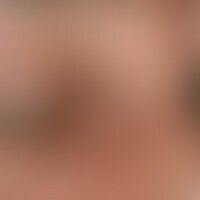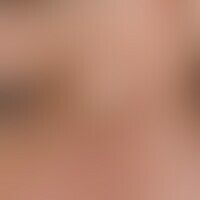Full skin transplantation Images
Go to article Full skin transplantation
Full skin transplantation. Fig. 1 a: Erosive, bowl-shaped sunken tumor with central hemorrhagic crust and marginal wall formation in the area of the inner eyelid angle. The tissue sample for histology revealed a solid basal cell carcinoma.

Full skin transplantation. Fig. 1 b: Skin condition 1.5 years after preauricular full skin transplantation. From the inner corner of the eye via the orbital rim and the ductus nasolacrimalis, basal cell carcinomas can penetrate to the eye and nasal cavity and via the ethmoid cells to the base of the skull. Microscopically controlled surgery of the exisate, preferably in the form of 3-D histology, must be performed before covering the defect after tumor excision.

Full-thickness skin transplantation. Fig. 2: Hypertrophic supraclavicular full-thickness skin transplant on the bridge of the nose after excision of a basal cell carcinoma.

Full-thickness skin transplantation Fig. 3: Flap shrinkage and patch phenomenon after basal cell carcinoma removal and retroauricular full-thickness skin transplantation to cover defects at the transition from the infraorbital region to the nasal slope and at the transition from the nasolabial fold to the nasal wing.